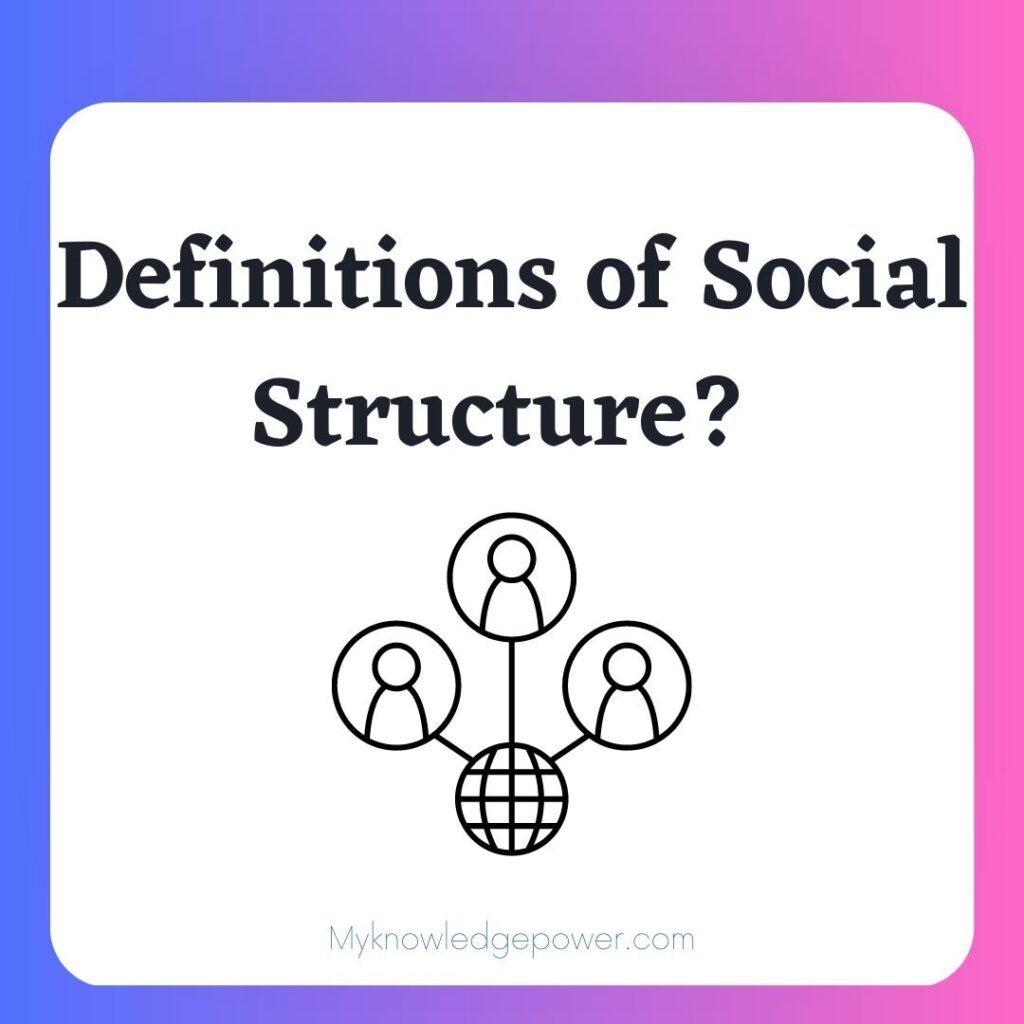Definitions of Social Structure In Sociology Notes Study Material BA 1st Year
Meaning and Definitions of Social Structure One person living in the company of other persons in society. When the men relate themselves with each other, they form a structural form which may be a group, an association, or an organization. Definitions of Social Structure In Sociology Notes Study Material BA 1st Year. Social structure is composed of such structural forms that are arranged in an interrelated way so that human beings operate and conduct themselves in a harmonious manner. As a matter of fact, social structure is an abstract concept referring to the external aspects of society. Groups, institutions, associations, and organizations.


The various units of social structure.
MacIver defines social structure as The various modes of grouping together comprising the complex pattern of social structure. In the analysis of the social structure, the role of diverse attitudes and interests of social beings is revealed.”
Brown says that The components of social structure are human beings, the structure itself being an arrangement of persons in relationships institutionally defined and regulated.
Ginsburg is of the view that “Social structure is concerned with the principal forms of social organisation ie., types of groups, associations and institutions and the complex of these which constitute societies.”
Nadel writes We arrive. at the structure of society through abstracting from the concrete population and its behaviour, the pattern of network or system of relationship obtaining between actors in their capacity of playing roles relative to one another.?’
Karl Mannheim is of the view that “Social structure is the web. of interacting social forces from which have arisen the various modes of observing and thinking.”
Johnson writes that The structure of anything consists of the relatively stable inter-relationships among its parts. Moreover, the term ‘part’ itself implies a certain degree of stability. Since a social system is composed of the – inter-related acts of people, its structure must be sought in some degree of regularity or recurrence in these a is.
Parsons is of the view that. Social structure is a term applied to the particular arrangements of the interrelated institutions, agencies and social patterns as well as the statuses and roles which each person assumes in the group.
Elements of Social Structure
Various elements of social structure are as below:
- Normative System: The society is presented along with the ideals and values through the normative system. There is an interrelation of institutions and associations in accordance with these norms. The people are expected to play their roles in accordance with the approved norms of society.
- Position System: Different status and roles of the individual are included within the position system. Different individuals have different desires and aspirations. These desires and aspirations can be fulfilled only when different people are assigned different roles according to their capacities and efficiencies. As a matter of fact, the proper functioning of the social structure rests upon whether roles and status have been properly assigned or not.
- Sanction System: There is a sanction system in every society so that there is due enforcement of prevailing norms. Various, parts of social structure may be integrated and coordinated only when there is confirmation of social norms. Those who disregard social norms are liable to bear punishment according to the gravity of non-conformity. Only that social structure is stable where an effective social system prevails.
- Anticipated Response System: The individuals are invited to participate in the social system through, the anticipated response ‘system. Adequate and efficient functioning of social structure is based on the realization of their duties by the people and their efforts. for the fulfilment of those duties.
- Action System: The entire social structure revolves around the action system. The action is the reason that sets the social structure in motion.
The main characteristics of social structure are as below:
Realization of Outer Form of Society:
Social structure does not relate to the functioning of social units. Hence, we come to realize only the outer form of social structure. As in our physical structure, we find the nose, ear, lips, hands, legs etc, are in proper order and which makes our body, similarly, different units forming society create outer-social structure when they are joined in proper order. This outer form of society is known as social structure.
Social Structure is Orderly Serial of Different Units:
Social structure is formed of different units. These different units are not disordered but mutually related. For example, when different parts of a cycle are placed, that would merely be a help of the parts, but when those parts are arranged in proper order, that would become a cycle. Similarly, when different units of society are in proper order, they form a social structure.
Social Structure is Abstract:
Social structure is a creation of different institutions and associations that we can neither see nor touch. We just can experience social structure.
Inter-relation of Different Units is Comparatively Stable:
Most sociologists consider social structure as a stable concept. Different groups, sub-groups, associations, and institutions that go to make social structure are usually stable, and this is the reason why even social structure is stable.
Every Unit of Social Structure Has a Certain Position:
Every unit of social structure has a certain position and remaining in that position helps in the formation of social structure. This is not possible for that unit to change the position of its own will. For example, a family cannot take the place of the court, nor can the court occupy the place of an educational institution.
Social Structure is a Movable Concept:
This is true that as there is stability in social structure, there is also some mobility. For example, if a family is a stable unit, there is still the possibility of changes. Social structure relates to society. When society changes, the social structure also changes. In our country, till recently joint families were preferred, but now people prefer nuclear families. Similarly, the forms of associations and institutions also change, and with that change social structure.
Social Structure is Influenced by Local Considerations:
Every society is different in its structure than the other society for the reason that there are local geographical, and cultural peculiarities influencing social structure.
Social Processes Help in the Formation of Social Structure:
There are several cooperative and non-cooperative processes that go to make the social structure. The cooperative processes involve unification and cooperation etc. and non-cooperative processes involve conflict and competition etc.




1 Comment
Pingback: Difference Between Ascribed and Achieved Status Sociology Notes